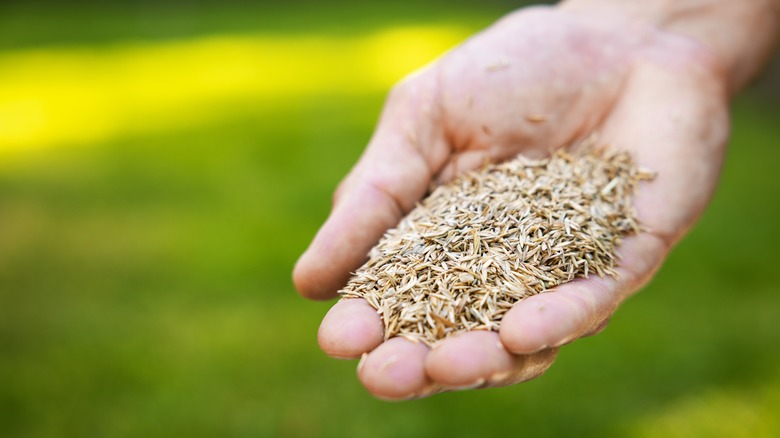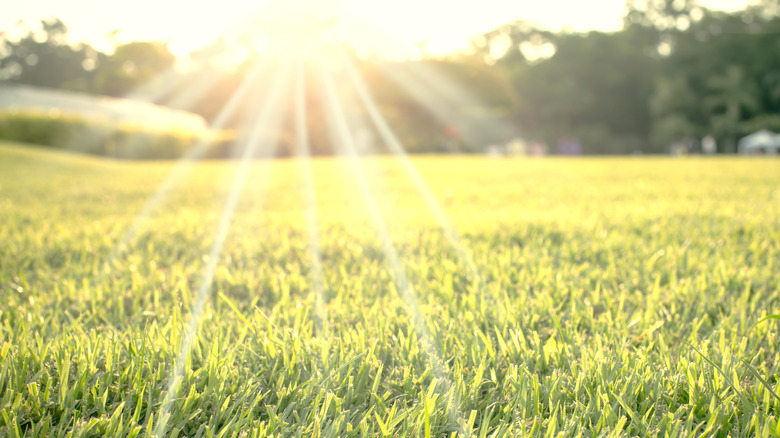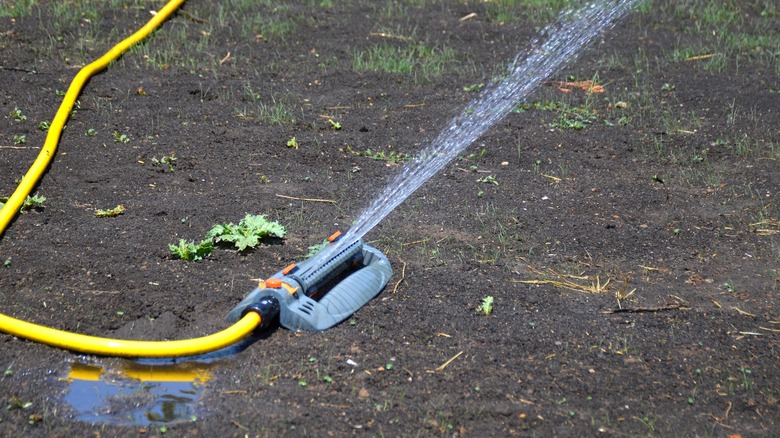Can You Really Plant Cool-Season Grass In Summer? Here's The Truth
When you start to notice bare spots on your lawn in summer, you might not care about the best time of year to overseed your lawn. You simply want to take care of the bare spots now. But if your lawn primarily consists of cool-season grasses — like Kentucky bluegrass, ryegrass, and fescue — you might be unsure whether you can plant more of these cool-season grasses during the hottest part of the year. Depending on where you live and the soil temperatures you experience, you may be able to plant cool-season grass seeds in early summer, but you'll need to commit more time for care and watering to have a successful outcome.
Cool-season grass germinates when soil temperatures are between 50 and 60 degrees. To accurately measure soil temperature, you can buy a soil thermometer with a probe that goes a few inches under the ground. If you cannot measure soil temperatures, air temperatures that are between 60 and 75 degrees roughly translate to 50-to-60-degree soil temperatures.
So what can you do when planting cool-season grass seed in summer? Lowering the soil temperature through watering is one option. Avoid planting the grass seed in primarily sandy soil, which can heat up beyond the ambient air temperature. If you can plant in areas that have some shade and avoid harsh sunlight all day, that can help germination, too.
Why do cool-season grass seeds struggle to germinate in summer?
Just as people and animals have different capabilities of tolerating hot days through sweating, panting, or other means, different species of grass have different tolerances for high temperatures. The best grasses for places with cool weather have the ability to tolerate significant temperature fluctuations, but they grow best when soil temperatures are moderate.
These cool-season seeds need the right mixture of moisture and soil temperature to allow for germination. When exposed to high soil temperatures, the metabolic process of the grass slows down, resulting in slow or no growth, which could prevent germination. Additionally, the seeds can dry out before absorbing the moisture they need to sprout. If the cool-season seeds manage to sprout, the slow growth in summer might allow weeds to take over, stealing nutrients that the grass needs when soil temperatures cool again in autumn and it's ready to grow.
On the other hand, warm-season grasses are able to tolerate heat in the soil better than cool-season grasses because they originate from areas of the world where they routinely experience extremely high temperatures. Consequently, warm-season grasses can germinate at 65 to 70 degrees soil temperature, which is quite a bit warmer than the soil temperatures where cool-season varieties can germinate. Warm-season grasses include bermuda, centipede, zoysia, and St. Augustine.
Options for reducing soil temperature to help cool-season grasses
If you want to stick with cool-season varieties when choosing grass seed for a healthy lawn in summer, you can try a few options to reduce the soil temperature into a comfortable range for germination. For starters, water the soil regularly to try to keep its temperature lower. Watering early in the morning just as the sun is rising or just before dawn could lower the soil temperature by 7 to 10 degrees Fahrenheit throughout the day. A second light watering late in the afternoon can help on especially hot days. Avoid over-watering the soil, though, which could cut off oxygen levels and starve the roots on the seedlings.
You might also choose to cover the soil where you planted the cool-season grass seed with a very light layer of peat moss. This can preserve the moisture in the soil, helping with germination and reduced soil temperatures. However, you have to avoid using too much peat moss, which can suffocate the cool-season seeds and prevent them from germinating. Use a layer of peat moss that's less than 1/2 inch in thickness for the best results.
Another option is planting the cool-season grass seeds only on areas of the lawn that have some shade to avoid direct sunlight most of the day. Additionally, look at the weather forecast and try to avoid planting the seeds when the upcoming weather will combine high humidity, high temperatures, and a lot of rain. Wait for a period of cooler temperatures in the forecast to plant the seeds.


